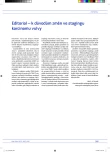The Clinical, Histopathological and Imaging Methods Characteristics of Non ‑ Hodgkin Lymphomas in Patients with Brain Involvement
Authors:
S. Vokurka 1; R. Tupý 2; L. Boudová 3; J. Mraček 4; P. Jindra 1; J. Ferda 2; M. Hrabětová 1
Authors‘ workplace:
Hematologicko‑onkologické oddělení LF UK a FN Plzeň
1; Klinika zobrazovacích metod LF UK a FN Plzeň
2; Patologicko‑anatomický ústav LF UK a FN Plzeň
3; Neurochirurgické oddělení LF UK a FN Plzeň
4
Published in:
Klin Onkol 2013; 26(5): 348-353
Category:
Original Articles
Overview
Background:
The Non ‑ Hodgkin‑lymphoma (NHL) brain infiltration carries a poor prognosis. Because of relatively rare incidence, we decided to share our experience.
Patients and Methods:
Retrospective analysis of patients with NHL brain infiltration diagnosed in 2001 – 2011 at our university hospital.
Results:
Twenty ‑ seven patients with median age of 61 (range 42 – 82) years were analyzed. The primary diffuse large cell B ‑ cell lymphoma of CNS was defined in 22/ 27 (81%) patients, in the others systemic NHL was present. Median positivity of the proliferative marker Ki ‑ 67 was 80%, the number of NHL lesions 1 (1 – 8), diameter 28 × 30 × 29 (11 × 16 × 20 to 85 × 76 × 65) mm. The fundamental finding in brain lymphoma MRI imaging was lesion with predominantly homogenous contrast enhancement, diffusion restriction and collateral edema. Thirteen out of 27 (48%) patients underwent lumbar puncture, and lymphoma presence in fluid was detected in only two of them. The most frequent symptoms were limb paresis or hemiparesis (55%), bradypsichysm (22%), expressive aphasia (22%), cephalea (18%). Corticosteroid therapy, as a primary treatment option, was indicated in 15% of patients with a median overall survival of one month, CNS radiotherapy in 37% with a median survival of three months, and chemotherapy in 48% patients with a median overall survival 10 (2 – 45) months.
Conclusion:
The brain lymphomas are rare and prognostically very unfavorable affection. When specifying brain focal lesions on MRI, it is necessary to consider this etiology and to elect imaging protocols with contrast agents and diffusion weighted sequence. Biopsy should be performed prior to start of corticosteroid therapy. Intensive chemotherapy or radiotherapy indication must be individually considered, and proposed treatment should be initiated immediately with a potential for somewhat prolonged survival.
Key words: Submitted: Accepted:
lymphoma – brain – magnetic resonance imaging – neurosurgical procedures – cranial irradiation – chemotherapy
The authors declare they have no potential conflicts of interest concerning drugs, products, or services used in the study.
The Editorial Board declares that the manuscript met the ICMJE “uniform requirements” for biomedical papers.
29. 2. 2013
11. 7. 2013
Sources
1. Kozler P, Beneš V, Chytka T et al (eds). Intrakraniální nádory, 1. vyd. Praha: Galén 2007.
2. Swerdlow SH, Campo E, Harris NL et al (eds). WHO Classification of Tumours of Haematopoietic and Lymphoid Tissues. 4th ed. World Health Organization 2008.
3. Ferry JA. Lymphomas of the Nervous system and the Meninges. In: Ferry JA (ed.). Extranodal Lymphomas. Philadelphia, USA: Elsevier Saunders 2011 : 7 – 33.
4. Lymphoma.cz [internetová stránka]. Czech Lymphoma Study Group – Kooperativní Lymfomová Skupina, Česká republika; c2013. Dostupné z: http:/ / www.lymphoma.cz/ intro.php.
5. Belada D, Trněný M, Kooperativní lymfomová skupina (eds). Diagnostické a léčebné postupy u nemocných s maligními lymfomy. 4. vyd. Hradec Králové: CREDIT s.r.o. 2011 : 72 – 74.
6. Ghesquieres H, Tilly H, Sonet A et al. A Multicentric Prospective Phase 2 Study of Intravenous Rituximab and Intrathecal Liposomal Cytarabine in Combination with C5R Protocol Followed by Brain Radiotherapy for Immunocompetent Patients with Primary CNS Lymphoma: A Lymphoma Study Association (LYSA) Trial. Blood 2012; 120: abstr. 796.
7. Pánková J, Benešová E, Klener P et al. Primární lymfom centrální nervové soustavy. Klin Onkol 1998; 11(4): 112 – 115.
8. Boudová L, Fakan F, Škůci I et al. Lymfomy centrálního nervového systému. Klinickopatologická studie 70 případů. Abstrakt 004. In: Sborník abstrakt. XII. Jihočeské onkologické dny. Český Krumlov, 13. – 15. října 2005.
9. Fabian P, Boudová L. Poznámky ke 4. vydání klasifikace lymfomů WHO. Klin Onkol 2009; 22(3): 121 – 122.
10. Kopal A, Ehler E, Kerekes Z et al. Primární lymfom mozku. Neurol Prax 2010; 11(2): 129 – 132.
11. Trněný M, Vášová I, Pytlík R et al. Distribuce podtypů non‑hodgkinského lymfomu v České republice a jejich přežití. Klin Onkol 2007; 20(5): 341 – 348.
12. Batchelor T, Lesser G, Grossman S et al. Rituximab monotherapy for relapsed or refractory primary central nervous system lymphoma. Annual meeting of the American Society of Clinical Oncology. Chicago, USA: May 30–June 1, 2008: abstr. 2043.
13. Reddy N, Savani BN. Primary central nervous system lymphoma: implication of high‑dose chemotherapy followed by auto ‑ SCT. Bone Marrow Transplant 2012; 47(10): 1265 – 1268.
Labels
Paediatric clinical oncology Surgery Clinical oncologyArticle was published in
Clinical Oncology

2013 Issue 5
Most read in this issue
- Management of Infections in Palliative and Terminal Cancer Care
- Chylous Ascites as a Serious Complication of the Neuroendocrine Tumor of Ileum – Case Report
- Nephroblastoma – 30-Years Period of its Treatment in the University Hospital Motol, Prague
- Onkogeny RAS – prediktivní molekulární marker u kolorektálního karcinomu
